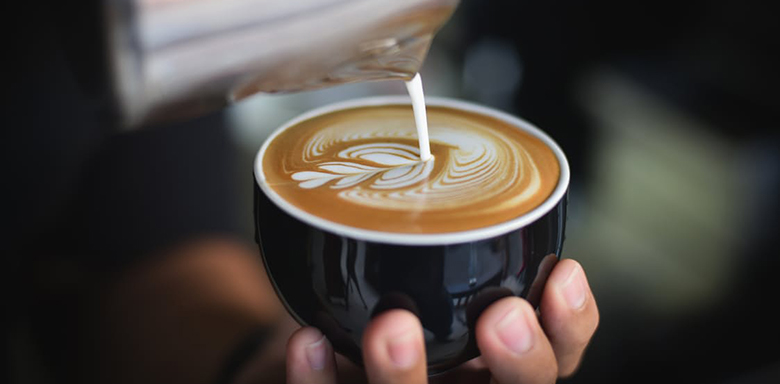How To Make A Latte

Key ingredients
- Espresso
- Steamed Milk
- Foamed Milk
Equipment
- Coffee machine with steam wand/arm
- Milk jug
- Thermometer
Difficulty rating
Quick guide
- Prepare an espresso (single or double) directly into a latte glass
- 1/3 fill your milk jug — whole milk is recommended
- Purge your steam arm prior to attempting to steam your milk
- Foam your milk prior to brewing your espresso, paying attention to creating a nice smooth microfoam
- After foaming/frothing your milk, gently tap the jug or bump on a table to remove any unwanted large air bubbles
- Begin pouring the frothed milk to your espresso from a relatively high position
- Continue to pour whilst lowering the milk and steepening your pouring angle
- Ensure a small amount of stiff milk foam sits on top after pouring
- Enjoy your Latte!
The Grandfather of the speciality coffee scene
A stalwart adjudicator of the World Latte Art Championship, Paul Meikle-Janney certainly knows what it takes to make an exceptional latte. Here Paul talks us through the required steps needed to make a truly sumptuous latte.
As with all speciality drinks it is important to get the espresso right, but there is also a knack to frothing your milk, something which Paul explains.
Video guide
With a latte, it is important not to introduce too much milk foam to the drink. Instead, you should be aiming for a nice, thin layer of foam to top off the latte.
First, fill your filter basket with the correct level of coffee and set your espresso to brew into your latte glass. Whilst this is happening and the machine is working its magic, you should start to heat the milk.
Given that milk makes up about 2/3rds of a latte, it is vital to get this stage right.
Top tip: If you’re starting out, don’t be afraid to split the espresso making and milk frothing into two separate tasks.
Just as you would when creating a cappuccino and other speciality beverages, we suggest only 1/3 filling your milk jug.
This is because there needs to be enough space in the container for the milk to expand but, on the other hand, there needs to be enough present to achieve the required foaming motion.
Give the steam arm a quick purge and then place the arm just underneath the surface of the milk in order to introduce a little bit of air into the liquid.
After a few short, sharp 'chirps', raise the milk jug an inch or so and position the steam arm to the side which should initiate a nice swirling motion as the milk begins to evolve. Before the milk gets too hot and begins to lose its taste, turn off the steam arm and prepare to pour.
Pour the milk into your glass. Initially, start from a relatively high position – about an inch or two above the glass – and then gradually work your way down until the jug is almost resting on the glass, steepening the angle of the jug as you do so.
The Latte
A coffee classic that is universally adored

Coffee and milk go together like bread and butter, and the notion of mixing the two has been around for years.
Whether known as a café au lait, a caffe con leche or a milchkaffee, our continental friends were creating milky coffees for decades – if not centuries – before W.D Howells first mentioned the term ‘latte’ in an essay penned in 1867.
Despite existing in various forms across continental Europe it is the Americans who are widely credited for popularising and commercialising the drink.
Synonymous with the Seattle coffee scene of the 1980s, the latte soon became the standard speciality drink of choice of many and has remained a popular option ever since.
Essential Latte Making Tools
The established king coffee needs to be taken care of properly

 Espresso machine
Espresso machine
 Milk jug
Milk jug Thermometer
Thermometer Cappuccino cups
Cappuccino cups